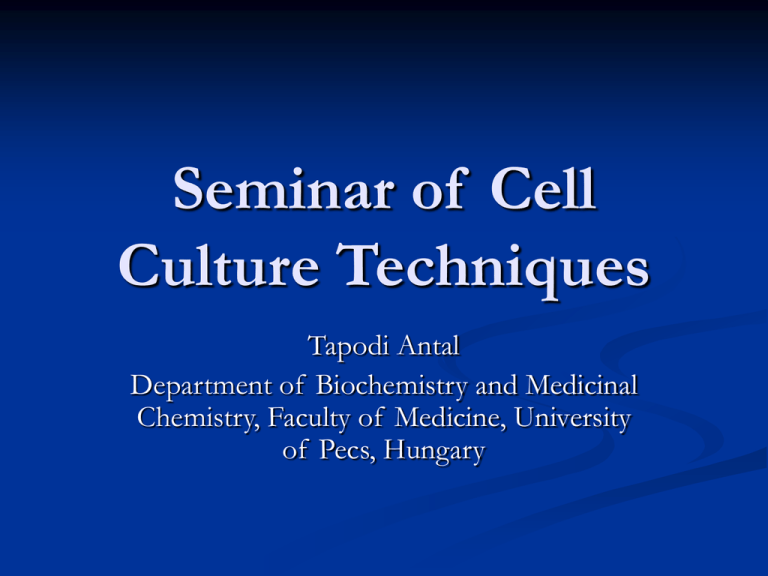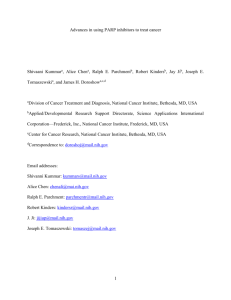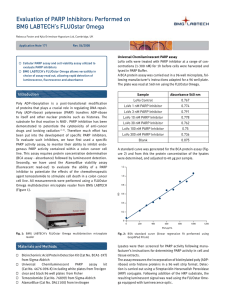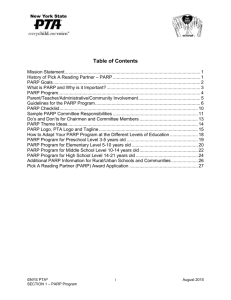Seminar of Cell Culture Techniques
advertisement

Seminar of Cell Culture Techniques Tapodi Antal Department of Biochemistry and Medicinal Chemistry, Faculty of Medicine, University of Pecs, Hungary Contents I. Cells Types II. Introduction to Cell Culture Lab III. Techniques I. Cell Types Primary cultures Secondary cultures Normal Immortalized Spontaneous Transformation Transfection Somatic Cell Fusion (Hybridomas, Hybrids) Cell lines Adherent Suspension Cells from ATCC and ETCC 1. Primery Cultures Tissue preparation from young animal, or isolation of cells from blood, intraperitoneal fluid, etc. Tissue dissociation Dissection then Homogenization with Knife or Blender Enzymatic Digestion (collagenase, papain, trypsine)/cleaving of DNA of damaged cell with DNase Dissociation of cells in medium and selection of organic cell types CO2 Incubator Knife Blender 2. Secondary cultures H9c2 Normal cell lines They were spontaneously immortalized.(e.g.: Cardiomyocytes from rat) Immortalized HeLa Transfected with some sort of oncogene; SV40 (Simian virus)Large T antigen (T IDBL) Tumor cells (e.g.: Human cervix carcinomas: HeLa) Hybridomas Hybridomas Cell fusion of HGPRT and TK-/myeloma and B-cells from immunized animal Selection of hybridomas in HAT (Hypoxanthine, Aminopterine and Thymidine) medium Hybrid selection Metabolic pathways relevant to hybrid selection in medium containing hypoxanthine, aminopterin and thymidine (HAT medium). When the main synthetic pathways are blocked with the folic acid analogue aminopterin (*), the cell must depend on the “salvage” enzymes HGPRT and TK (thymidine kinase). HGPRT (-) cells cannot grow in HAT medium unless they are fused with HGPRT (+) cells. Effect of HAT-medium Selection 5-Amino Imidazole4-Carboxy Ribonucleotide * 5-Formido-Imidazole4-Carboxamine Ribonucleotide PRPP PP Hypoxanthine Inosine Monophosphate Hypoxanthine Guanine Phosphoribosyl Transferase (HGPRT) Guanine Guanosine Monophosphate (GMP) PRPP PP Thymidine Thymidine kinase UDP RNA dTMP dTDP * Thymidylate Synthetase dUTP dUMP GDP dGDP GTP dGTP d TTP dCTP DNA dATP Production of Polyclonal and Monoclonal antibodies Neuro Hybryds It works with adherent cells. Cell fusion of HGPRT and TK-/-, no secreting neuoblastoma and neural cells. Selection in HAT medium Cell lines Adherent (WRL-68, HepG2, HeLa etc.) Suspension (Jurkat) Cells from ATCC and ETCC WRL-68 Jurkat HeLa HepG2 Online Order of Cell Lines II. Introduction of Cell Culture Lab (Equipment) CO2-thermostats Airflow Solutions Dishes Freezers Liquid nitrogen Centrifuges Autoclave Vacuum ovens Cryotubes Microscopes ELISA-readers CO2 Incubators Water Jacketed CO2 incubator 3 Gas/CO2 Incubator with RH Control Precise control of Oxygen levels combined with CO2, N2 and RH ensure accurate conditions for applications such as, hypoxic cell studies and cancer research. Laminar Flow Box HEPA filter rated at 99.99% efficient for 0.3 micron particulates. The HEPA filtered air is then directed vertically across the work surface. Dishes Dishes Multiwell plates Flasks Flasks on slide Freezers Centrifuges Autoclaves Vacuum Ovens Microscopes ELISA readers FACS II. Introduction of Cell Culture Lab (Culture) Growth of the cells in adequate media with serum (FCS/FBS) and antibiotics and antimycotics (chemically defined serum-free media) Environment: Temperature: 37°C (34 °C, 41 °C) High humidity 5% CO2 Split: Trypsin-EDTA Count of Cells (Thrypan Blue) III. Techniques Metabolic activity (MTT) Detection of Apoptosis and Necrosis Western blot from cells Transfection Gene deletions (Demonstration) Clinical Application of cultured Human Stem Cells Flow Cytometric Methods FISH-probes DNA Array Metabolic activity (MTT, viability assay) Seed the cells into 96-well plates at a starting density of 10 4 cell/well and culture overnight in humidified 5 % CO2 atmosphere at 37 °C. Treat the cells modifying the their viability the following day. Remove medium from the wells containing 0,5% water suluble mitocondrial dye, (3-(4,5-dimethylthiazol-2-yl]-2,5-diphenyltetrazolium bromide (MTT+) Incubate 3 hours and solubilize the water insoluble blue formasan dye by 10% SDS in 10mM HCl Determine the optical density by an ELISA reder at 550 nm wavelength Effect of HO-3089 (Novel PARP-inhibitor) on WRL-68 in Oxidative Stress 100 Survival (%) 80 60 40 20 0 Ctrl. 0 0,1 0,5 M HO-3089 1 2 Detection of Apoptosis and Necrosis Activity of Caspase 3 and Caspase 8 Release of Cytochrome c and AIF Fluorescence dyes Hoechst 33342 Annexin V Propidium iodide Rhodamine DNA Laddering Induction and protection PARP Apoptosis signalling Activation and inhibition of Apoptosis The Roll of mitochondria in apoptosis Caspase Cascade Fluorescent dyes I. Hoechst 33342:blue Selective nuclear dye Chromatin condensation, fragnentation Rhodamine 110: green Bis-L-asparic acide amide (substrate by caspase 3): green TMRE: polarization of mitochondria: red Fluorescent dyes II. Propidium iodide: Latestage apoptotic and necrotic cells: red YO-PRO-1: Viable cell nuclei green Annexin V: early-stage apoptotic cells: green DNA Laddering To investigate the DNA fragmentation, the extracted DNA has to run on 1,5% agarose gel. DNA fragments show ‘ladderpattern’. DNA Laddering Detection of Apoptosis and Necrosis Activity of Caspase 3 and Caspase 8 Release of Cytochrome c and AIF Fluorescence dyes Hoechst 33342 Annexin V Propidium iodide Rhodamine DNA Laddering Induction and protection PARP Induction and Protection of Apoptosis Induction: Hydrogen peroxide Etoposide Death domains: TNF, FAS, TRAIL BAD Protection: BCL-2 family IAP Inhibition of PARP HSP27,70,90 PARP(poly-ADP-rybose-polymerase) Nuclear enzyme Structure of PARP 1st activator of PARP are ssDNA-breaks The roll of PARP in necrosis and apoptosis or repair-mechanism The roll of PARG Reaction catalyzed by PARP Ad Nic-R-P-P-R Ad (NAD+) Ad R-P-P-R-R-P-P-R Ad Ad Ad N PARP Glu -R-P-P-R-R-P-P-R-R-P-P-R-R-P-P-R + Nic CONH2 III. Techniques Metabolic activity (MTT) Detection of Apoptosis and Necrosis Western blot from cells Transfection Gene deletions (Demonstration) Clinical Application of cultured Human Stem Cells FISH-probes Flow Cytometric Methods DNA Array Transfection I. pEGFP with NLS Expression vector systems pcDNA pEGFP pEGFP without NLS Transfection II. RNAi siRNA stRNA or Dicer RNAi shRNA Using vectors for RNAi analysis siRNA cassette Proposed mechanism for how siRNA works stRNA or Dicer RNAi Gene deletion (Demonstration) Clinical Application of cultured Human Stem Cells Not only can human embryonic stem cells be cultured in the laboratory. But cells may be manipulated to produce cultures and Characteristics of particular tissue. Possibility by damage and ageing (Parkinson’s disease, diabetes) Epithelial Stem Cell identification and isolation First methods involved in the separation of an epithelial cell type from other cells will be examined, followed by ways in which the proliferative capacity of such a cell type can be assessed. Secondly, methods used for the maintenance of primery stem cells in culture and ways of caracterizing stem cells using immunocytochemistry will be described. FISH (Fluorescence in situ Hybridization) Application of FISH-probes Prenatal, Postnatal and Preimplantation Genetics Oncology, Cytology & Pathology Hematological Cancer Etc. Equipments: Fluorescence Microscope Dye adequat filter sets Sample and Reference DNA Detection of Bladder Cancer The probe was designed to detect aneuploidy for chromosomes 3, 7, 17 and loss of the 9p21 locus via fluorescence in situ hybridization (FISH) in urine specimens from subjects with transitional cell carcinoma of the bladder. two copies of chromosome 3 (red), four copies of chromosome 7 (green), five copies of chromosome 17 (aqua) and one copy of p16 gene (gold) Flow Cytometric Methods Separation of labeled cells Clinical applications DNA Array technique Mr. Péter Jakus Cell suspension by NMR Dr. Zoltán Berente











